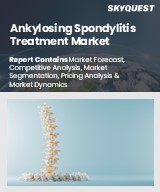
Report ID: SQMIG35D2295
Skyquest Technology's expert advisors have carried out comprehensive research on the ankylosing spondylitis treatment market to identify the major global and regional market trends and growth opportunities for leading players and new entrants in this market. The analysis is based on in-depth primary and secondary research to understand the major market drivers and restraints shaping the future development and growth of the industry.
Rising Prevalence of Ankylosing Spondylitis
Advancements in Biologic Therapies
Limited Awareness and Late Diagnosis
Adverse Effects and Contraindications of Long-Term Drug Use
REQUEST FOR SAMPLE
Global Ankylosing Spondylitis Treatment Market size was valued at USD 4.70 Billion in 2023 poised to grow from USD 4.92 Billion in 2024 to USD 7.14 Billion by 2032, growing at a CAGR of 4.75% in the forecast period (2025-2032).
Global ankylosing spondylitis treatment market competition is characterized by innovation-fostered competition among major players such as AbbVie Inc., Pfizer Inc., Eli Lilly and Company, Novartis AG, and Johnson & Johnson. Firms emphasize biologic innovation, increasing biosimilar offerings, and strategic collaborations. AbbVie leverages Humira's heritage while driving Rinvoq forward, while Novartis fortifies market presence with Cosentyx and aggressive participation in clinical trials for the next-generation IL-17 inhibitors. 'AbbVie Inc. (USA)', 'Pfizer Inc. (USA)', 'Eli Lilly and Company (USA)', 'Johnson & Johnson (USA)', 'Novartis AG (Switzerland)', 'Merck & Co., Inc. (USA)', 'Amgen Inc. (USA)', 'Boehringer Ingelheim GmbH (Germany)', 'UCB S.A. (Belgium)', 'Roche Holding AG (Switzerland)', 'AstraZeneca plc (United Kingdom)', 'Bristol-Myers Squibb Company (USA)', 'Biocon Limited (India)', 'Samsung Bioepis Co., Ltd. (South Korea)', 'Takeda Pharmaceutical Company Limited (Japan)'
The increasing global prevalence of ankylosing spondylitis, particularly among younger populations, is a major driver. This increase in diagnosed cases is driving demand for effective treatments, and healthcare systems and pharmaceutical firms are investing more in drug development, diagnostic technologies, and patient-focused care strategies to address increasing therapeutic demands.
Biologics Innovation Driving Therapeutic Evolution: The transition to biologics, such as TNF and IL-17 inhibitors, is revolutionizing ankylosing spondylitis therapy by providing targeted therapies with better efficacy. Ongoing R&D and growing biosimilar portfolios are driving market growth, as providers and patients increasingly prefer biologics for long-term disease management and enhanced quality of life.
What makes Reimbursement Policies in North America Favorable for AS Care?
Want to customize this report? This report can be personalized according to your needs. Our analysts and industry experts will work directly with you to understand your requirements and provide you with customized data in a short amount of time. We offer $1000 worth of FREE customization at the time of purchase.
Feedback From Our Clients

Report ID: SQMIG35D2295
sales@skyquestt.com
USA +1 351-333-4748